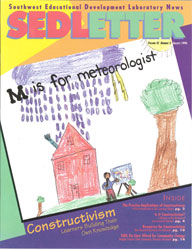Editor's Note: How Do Learners Learn?
How do learners learn? A rich and growing body of literature argues that learning is more meaningful when learners construct their own knowledge, following tenets of the learning theory known as constructivism.
This issue of SEDLetter explores constructivist practices for learners of all ages. The discussion opens with "The Practice Implications of Constructivism." This summary of the constructivist learning theory is by Wesley A. Hoover, a SEDL vice president who directs SEDL's Eisenhower Southwest Consortium for the Improvement of Mathematics and Science Teaching, where staff conduct constructivist-based teacher professional development programs in the Southwestern Region. "Resources for Constructivism," a selection of information products produced by education research facilities across the country, also appears.
What does a constructivist classroom look like? Perhaps it resembles the learning environments of science specialist Joyce Tate and performing arts specialist Kimberly Bissell. They both teach at the J. S. Clark Magnet School, a mathematics, science, and computer academy for primary school pupils in Monroe, LA, and describe their teaching methods in "Is It Constructivism?" by SEDLetter editor Mimi Mayer. Artwork by J. S. Clark students brightens SEDLetter as well. During 1995-96 students produced Weather and the ABCs, a book involving nearly every J. S. Clark student. Kindergartners through second graders drew weather scenes while third and fourth graders dreamed up a weather-related word for each letter of the alphabet. Fifth and sixth graders researched the weather words and embellished the youngest children's drawings with fitting illustrations. We're pleased to share this delightful marriage of science and art with our readers.
The issue closes with SEDL On-Line where David Foster, a SEDL senior technology associate, reviews New Community Networks: Wired for Change by community network advocate Douglas Schuler. Schuler explores the uses of technologies to explore linkages among individuals, resources, and institutions within communities.
Next Article: The Practice Implications of Constructivism

